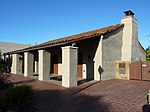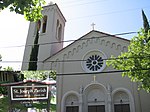Downtown Mountain View station
1987 establishments in CaliforniaCaltrain stations in Santa Clara County, CaliforniaFormer Southern Pacific Railroad stations in CaliforniaRailway stations in Mountain View, CaliforniaRailway stations in the United States opened in 1987 ... and 4 more
Santa Clara County, California railway station stubsSanta Clara Valley Transportation Authority bus stationsSanta Clara Valley Transportation Authority light rail stationsTram stubs

Downtown Mountain View station is an intermodal transit station located in Mountain View, California. The station is served by Caltrain commuter rail service, Santa Clara VTA light rail service, VTA local buses, and local shuttles. Downtown Mountain View is the western terminus of the Orange Line light rail route. The station has one island platform serving the two light rail tracks and two side platforms serving the two Caltrain tracks. The station building was constructed in 2000 to replicate the demolished 1888-built Southern Pacific Railroad station. Two pieces of public art were added during the construction of the light rail line.
Excerpt from the Wikipedia article Downtown Mountain View station (License: CC BY-SA 3.0, Authors, Images).Downtown Mountain View station
Central Expressway, Mountain View
Geographical coordinates (GPS) Address External links Nearby Places Show on map
Geographical coordinates (GPS)
| Latitude | Longitude |
|---|---|
| N 37.394394 ° | E -122.075872 ° |
Address
Mountain View
Central Expressway
94041 Mountain View
California, United States
Open on Google Maps





